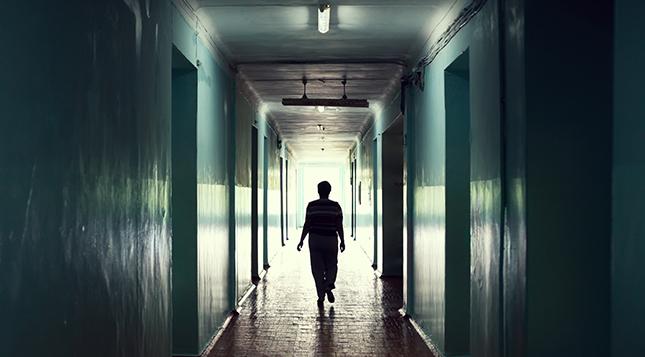Discharge Against Medical Advice After PCI Rare but Deadly
Checking out against doctors’ orders can have serious consequences and drive up costs. Understanding what drives patients to leave is a first step.

(UPDATED) Individuals who leave the hospital against medical advice following PCI are more likely to be readmitted within 30 days than patients discharged home by physicians, and the most common cardiac reason for readmission is an acute MI, according to the results of a new study.
Of those who left the hospital against medical advice after the index PCI, 16.8% were readmitted within 30 days compared with just 8.5% of those discharged home (P < 0.001). Among readmitted patients, nearly half of those initially discharged against doctors’ orders returned for cardiac-related reasons, with 39.4% of these patients returning because of an acute MI. For rehospitalized patients initially discharged home, 45.5% returned to the hospital for cardiac reasons, but just 19.4% of these patients had an acute MI.
“The other interesting aspect is that if a patient does come back into hospital with a myocardial infarction, the risk of mortality in those discharged against medical advice [following the index PCI] is much, much higher than in those who weren’t discharged against medical advice,” lead investigator Mamas Mamas, BMBCh (Keele University, Stoke-on-Trent, England), told TCTMD. “It suggests to me that the types of infarctions these patients are coming back with are really quite significant. It’s why the in-hospital mortality rates are so much higher in the acute MI population.”
Ajay Kirtane, MD (Columbia University Irving Medical Center, New York, NY), who wasn’t involved in the study, said the against-medical-advice discharge is a “failure of communication” among physicians, hospital staff, and the patient and is part of the challenging access to care in United States. Regarding the higher risk of readmission for cardiac causes in such discharged patients, it’s possible there wasn’t enough time for conversations about adequate post-PCI medical care, or the patient wasn’t fully titrated on optimal medical therapy, Kirtane suggested.
“It could also be that they are representative of a different sample of patients,” he told TCTMD. “It would be naive to say that this is only an education issue and has nothing to do with differences in the composition of the patient.”
The results of the study were published July 16, 2018, in JACC: Cardiovascular Interventions.
The Consequences
The rate of discharge against medical advice varies depending on the hospital setting, with as many as one in five emergency-department patients checking out against doctors’ orders. Comparatively, going home against medical advice is rare in the setting of PCI, said Mamas. Their group previously examined the burden of 30-day readmissions after PCI and showed discharge against medical advice was the strongest predictor of returning to the hospital. Despite this, little is known about how these patients fare once they leave the hospital following the index PCI.
In this analysis, which included 2,021,104 patients in the Nationwide Readmission Database (NRD) developed by the Agency for Healthcare Research and Quality, just 0.5% were discharged against medical advice.
Overall, individuals who checked out against advice were more likely to be younger, less likely to be female, less likely to be admitted for elective PCI, and more likely to be in the lowest income quartile. Those with an initial diagnosis of acute MI were also more likely to be discharged against medical advice following PCI, as were those admitted on a weekend and those receiving Medicaid. Substance abuse disorders involving drugs and alcohol were also independent predictors of leaving the hospital despite physician orders.
As with the authors’ previous analysis, being discharged against medical advice was the strongest predictor for hospital readmission at 30 days (OR 1.89; 95% CI 1.71-2.08).
For those discharged against medical advice following the index PCI, 5.0% of patients readmitted for an acute MI died during the hospital readmission. In contrast, just 2.4% of patients discharged home after PCI who were later readmitted for acute MI died in-hospital. Similarly, those discharged against hospital orders and readmitted for an acute MI had a threefold higher risk of in-hospital major adverse cardiovascular events compared with those initially discharged home after PCI.
To TCTMD, Mamas said the findings likely represent the “tip of the iceberg,” as the analysis only captures the against-medical-advice patients who survive to be readmitted to hospital. “It doesn’t capture the patients who die,” he said. “So I suspect that a lot of these patients discharged against medical advice might not survive until the readmission.”
In terms of noncardiac causes for hospital readmission, individuals who were discharged against medical advice were much more likely to return to the hospital for neuropsychiatric reasons, such as depression, bipolar and mood disorders, schizophrenia, and psychosis.
Mamas noted that if a patient was discharged against medical advice following the initial PCI and was later readmitted for an acute MI, one in six of these patients will again discharge themselves against doctors’ orders. “It’s incredible,” he said. “You’re discharged against medical advice the first time. You come back in with an MI and then go on to discharge against medical advice again.”
For those who were discharged against medical advice, the costs associated with readmission were also significantly higher than among those readmitted following discharge home. For those who were readmitted with an acute MI, the cost of readmission was significantly higher for those who left the hospital against medical advice after the index PCI that among those who followed hospital orders ($15,183 vs $11,936; P < 0.001).
Doctors’ Orders
Given the observational nature of the NRD analysis, the researchers don’t have data on compliance or medication adherence of those readmitted. However, Mamas suspects inadequate dual antiplatelet therapy (DAPT) is one likely reason for the higher rate of hospital readmissions among those who left the hospital against medical advice. Aside from stopping the patients leaving in the first place, Mamas said community outreach programs, either with the general practitioner or pharmacist, are needed to ensure that the PCI patients who leave receive proper postprocedural medical therapy.
Mamas pointed out that 59.2% of patients discharged against medical advice received a drug-eluting stent—as opposed to 75.8% of those who were discharged home—during the index PCI, meaning that physicians had recognized these individuals might be at high risk for leaving against hospital advice and thus might not receive adequate post-PCI medical care (or have other reasons for not complying with medical therapy).
To TCTMD, Kirtane said that when an individual is new to the hospital system, he or she might be overwhelmed and confused, which can lead to disagreements with physicians and staff. “Usually, the disagreement with medical care can be resolved with transparency and conversations, all the good things doctors and nurses try to do,” he said. “But occasionally there can be irreconcilable differences and that can lead to being discharged against medical advice.”
Although the number of patients checking out against doctors’ order is low, Kirtane said it might miss another group of patients who go home early, and while it wouldn’t be the physician’s preference, concessions are made for them to be discharged. “They might have a very compelling reason for leaving the hospital,” he said. “Ordinarily you might have kept them longer, but you don’t want them to sign the [against medical advice] papers. They’re discharged sooner than you’d like, but they wouldn’t be captured in this sample.”
If a patient does leave early because of these compelling, extraneous circumstances, Kirtane said he will institute a “nonstandard discharge plan,” which would intensify follow-up care with earlier phone calls. “In that situation, I’d make sure I had the patients cell phone number, and I’d make sure I called them to be sure they were doing okay,” he said, adding that usual care involves providing patients with a 30-day supply of medication before they leave hospital and such practice would also apply here.
In an editorial, David Faxon, MD, and Natalia Berry, MD (Brigham and Women’s Hospital, Boston, MA), state that while PCI for acute MI is highly effective for restoring blood flow and relieving symptoms, it warrants a strict medication regimen for the prespecified time interval. “Patients discharged against medical advice who are not compliant with DAPT would be at significantly increased risk for stent thrombosis and need for repeat revascularization,” they write. That risk is particularly pronounced if DAPT isn’t started, or is disrupted, within the first 7 days after PCI.
To TCTMD, Mamas noted that since individuals with neuropsychiatric disorders and those with substance abuse issues are at higher risk of quitting the hospital against medical advice, getting these patients in contact with mental health services at the time of PCI is a good idea. Faxon and Berry state that when medication affordability is an issue, “a course of DAPT should be physically provided to patients before they leave the hospital.”
Improved care and follow-up through early office visits, home visits, or telemedicine are also necessary if a patient goes home against physician orders, say Faxon and Berry. From a procedural perspective, use of stents that allow for shorter DAPT use might also be warranted in those at high risk for leaving early, they add.
Michael O’Riordan is the Managing Editor for TCTMD. He completed his undergraduate degrees at Queen’s University in Kingston, ON, and…
Read Full BioSources
Kwok CS, Bell M, Anderson HV, et al. Discharge against medical advice after percutaneous coronary intervention in the United States. J Am Coll Cardiol Intv. 2018;11:1354-1364.
Faxon DP, Berry NC. Post-percutaneous coronary intervention discharge against medical advice. J Am Coll Cardiol Intv. 2018;11:1365-1366.
Disclosures
- The researchers and editorialists report no relevant conflicts of interest.


Comments